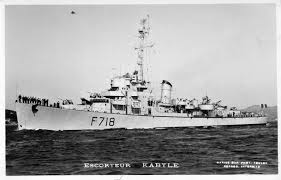U.S. Navy (1943–1950)
Following shakedown off Bermuda, Riddle sailed for Pearl Harbor via the Panama Canal, arriving on 1 February 1944. On 10 February she got underway as an escort vessel with Task Unit 16.11.6, bound for the Marshall Islands. Upon arrival she conducted anti-submarine patrols in the Roi Namur-Kwajalein-Majuro Atoll area until steaming for Pearl Harbor on 15 March.
After serving as an escort to Majuro Atoll and Manus Island and back, Riddle was active in the Marshall and Marianas Islands in June 1944. On 4 July, while screening fueling operations with task group TG 50.17, with David W. Taylor (DD-551), she successfully attacked the submerged I-10.
Riddle continued screening operations in the Marshall-Marianas area until 1 September when she anchored at Manus Island. On 4 October she got underway as part of an escort group to screen the sortie of task unit TU 38.8.16, a carrier and fueling group, from Seeadler Harbor for the Philippine Islands invasion. Riddle returned to Manus after the task unit was on its way, and operated in the Admiralty and western Caroline area until early January 1945. On 14 January 1945 she arrived at Leyte Gulf, Philippine Islands, after which she returned to the Marianas and western Carolines on routine screening and patrol duties.
Riddle operated in the Iwo Jima area in February 1945, acting as anti-aircraft and anti-submarine patrol as well as escorting various fleet units in their operations in that bloody battle area. On 5 March, she anchored at Saipan and the following day sailed for Leyte Gulf in company with Hyman (DD-732). After remaining in San Pedro Bay, Leyte Gulf, until 18 March, Riddle got underway as part of the escort group for task unit TU 51.7.1, en route to Kerama Retto, Okinawa.
Upon arrival at Kerama Retto on 26 March 1945, Riddle operated with various screening units, patrol sections, and retirement groups in those waters. 12 April found the vessel off Okinawa on a patrolling station, with task force TF 51, under enemy attack. Two Japanese kamikazes attacked Riddle. The first was shot down, just clearing the ship, and the second crashed into the ship killing one man and causing considerable damage. After transfer of wounded and repair to her battle damage at Kerama Retto, Riddle got underway on 16 April as an escort to Saipan.
Riddle arrived at Okinawa once more on 1 May 1945, and assumed patrol and escort duties there until 15 June when she got underway for Leyte Gulf. She arrived on 18 June and anchored there in San Pedro Bay, until 1 July. From 2 to 4 July, she participated in firing exercises with Salt Lake City (CA-25) and on the 5th got underway as escort for Shamrock Bay (CVE-84) en route to Guam and Hawaii, arriving Pearl Harbor on 19 July.
Riddle proceeded on to San Pedro, Los Angeles, for overhaul which lasted through the end of hostilities. On 13 November, Riddle got underway for the Panama Canal and arrived Norfolk, Virginia, on the 29th. On 31 December 1945 she reported to Commander, Florida Group, U.S. 16th Fleet, for inactivation, and decommissioned on 8 June 1946.

